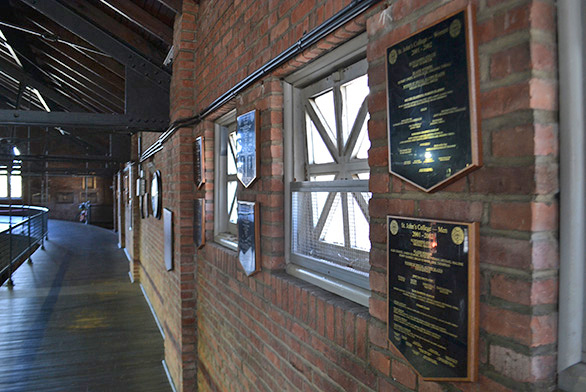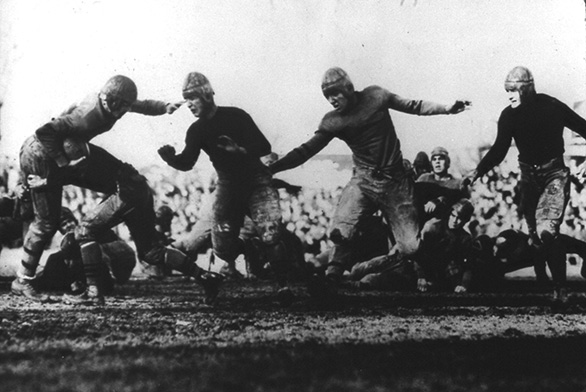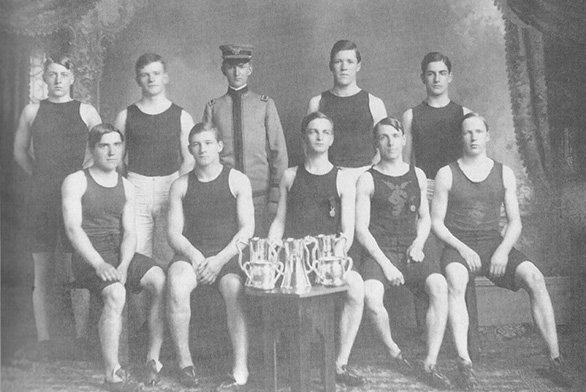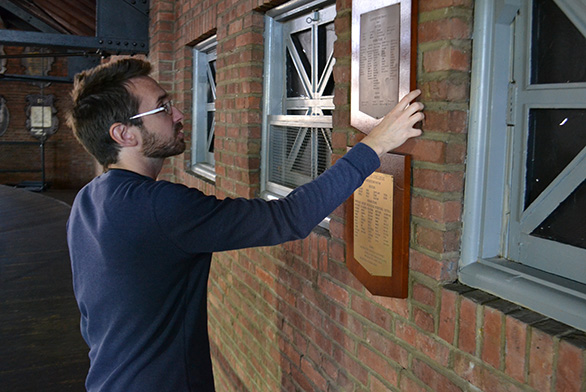St. John’s: Unlikely Pioneers of Sport
December 2, 2016 | By Tim Pratt

The plaques line the walls inside Iglehart Gymnasium on the St. John’s College campus in Annapolis.
Spartans. Hustlers. Greenwaves. Guardians. Druids.
The teams—and the players’ names listed with them—represent the ultimate in Johnnie athletic achievement: victory in intramural sports.
While St. John’s is known for its liberal arts curriculum, athletics at the college has a long and unique history. It’s one of glory and prestige, but also of hardship and change.
With the end of the fall intramural season, we took a look back at the 130-plus-year history of athletics at the college—intramural and intercollegiate—to examine its impact on Johnnie life.
“The intramural program and the athletic opportunities at the college are among the most important non-academic events on campus,” says Athletics and Recreation Coordinator Chris Krueger (A07). “Such a broad range and large number of students participate in these events. To continue to build on that is a priority—to take the strength and bolster it.”
The Beginning
The intramural program in its current form began in 1962 under former Athletic Director Bryce Jacobsen, a St. John’s alum.
But athletics played an important role in campus life since at least the 1880s, with the formation of intercollegiate football and baseball teams.
Leo Pickens, who ran the athletics programs at St. John’s from 1988 until 2012, documented the history thoroughly for a lecture he gave in 2005 called Of Kings, Levelers, Nymphs & Killer Bees: Glimpses of Our Athletic Past & Present. He studied old yearbooks, articles and other sources to compile a comprehensive history.
The findings of Pickens’ research may surprise some, given the college’s focus on the great books of Western civilization, and the fact that it has just four intercollegiate sports teams.

The St. John’s football team was one of the pioneers of the intercollegiate game.
Within a few years of its formation, the St. John’s Orange and Black—the school colors at the time—had achieved considerable success. The team went undefeated in 1888 and 1893, and claimed the title “Champions of the South.”
The college’s rivalry with Johns Hopkins University in Baltimore grew over the following decades, including the introduction of “Paint Parties,” in which students would sneak onto the opposing team’s campus and paint their school colors on some of the buildings. A Hopkins student was caught sneaking onto the Annapolis campus one year, Pickens says, and forced to sing the St. John’s school song in front of the whole student body.
The rivalry took a less-jovial turn in 1932 when a riot broke out between Hopkins and St. John’s students on College Avenue. Thirty-three people were arrested.
Baseball also had a notable presence on campus, but was replaced by intercollegiate lacrosse as the major spring sport in 1930.
The lacrosse team, formed in the early 1920s, won a series of national championships, including three in a row in the late 1920s and early 1930s. St. John’s even was chosen to represent the United States in an international lacrosse contest against Canada in 1931. St. John’s defeated the Canadians by a combined score of 5-4 over two games.
Several St. John’s alumni are in the National Lacrosse Hall of Fame.
Basketball also was a major varsity sport, and the college’s track and field team competed at meets against Georgetown University, the University of Virginia and the University of Pennsylvania.

Non-varsity sports formed on campus, too, including tennis, boxing, wrestling and gymnastics. Fraternities organized teams to play softball, touch football, basketball, handball and horseshoes. A swim meet was held in College Creek.
But trouble was on the horizon for St. John’s athletics.
The New Program
By 1937, when the New Program still in existence today was introduced at St. John’s, intercollegiate athletics was receiving criticism across the country.
It started in 1905, with President Theodore Roosevelt and others speaking out against the brutality of football. They called for changes, which ultimately were made, to make the game safer. The press also got involved, along with college officials, questioning the merits of intercollegiate sports.
This set the tone for St. John’s President Stringfellow Barr to announce in 1938 the end of intercollegiate athletics at the college.
“Beginning next September, St. John’s College will adopt a greatly expanded and exclusively intramural athletic season,” Barr announced. “When the St. John’s Program was inaugurated in September of last year, nobody expected it to find the proper support from the semi-professionalized system of intercollegiate athletics which American colleges have developed in recent years. The policy of the College requires the subordination of extracurricular activity to the main educational purposes.”
One week before Barr’s announcement of the abandonment of intercollegiate sports, he announced the abolition of the five fraternities on campus, stating they were “not conducive to producing a community of students.”
With all of the success of the St. John’s sports teams, Barr’s decision to end intercollegiate play wasn’t well received. A poll taken by the college newspaper showed students were overwhelmingly opposed to the action.
Some alumni, so upset by Barr’s decision, severed ties to the college.
Despite the changes, Johnnies weren’t without athletic opportunities. The intramural program that had originated in the late 1920s and early 1930s with the college’s physical education director, Joseph Novaks, would continue.

The goal was to provide athletic opportunities for all, even those who didn’t participate in intercollegiate sports. It’s a goal Krueger still pursues today.
By 1940, intramural participation had skyrocketed. The 1940 yearbook states 95 percent of students were actively participating.
Then World War II erupted. Athletic Director Ned Lathrop was called to active duty in 1941. Combined with declining enrollment, the lack of continuity led the intramural program to lose much of its vitality.
That would come to an end nearly two decades later, when Jacobsen became athletic director.
Continue on to Part 2: A New Era in Athletics.

